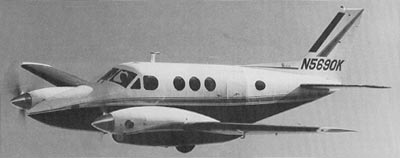Beechcraft has manufactured six different King Air models with the King Air 90 being the first model, appearing in 1964, after three years of design and test flights. The 90 is also the smallest of the fleet. From the beginning, the aircraft was identified with qualities such as dependability, consistent mechanical behavior and a stylish design. Never one to rest on their laurels, Beechcraft kept the prop to the grindstone and continued to improve their King Air 90 model.
 The aircraft has been subject to upgrades with state of the art design over the years making the aircraft much favored for corporate travel. The upgrades over the years led to a new and improved King Air 90 when the King Air C90 was born, rolling off the assembly line in 1971.
The aircraft has been subject to upgrades with state of the art design over the years making the aircraft much favored for corporate travel. The upgrades over the years led to a new and improved King Air 90 when the King Air C90 was born, rolling off the assembly line in 1971.
The weight of the plane was increased and the wingspan was upgraded in design, as well as an increase in cabin pressure. The rear fuselage was streamlined with greater efficiency for better flying speeds and the engines have been updated several times to increase flying time as well as increased takeoff and cruising speeds.
With the addition of an electrical landing gear system and a rudder boost system, the workload for the pilot was minimized. The wings were upgraded with a bonded spar cap rather than bolts to increase wing strength and eliminate bolt shear.
The result of the upgrades over the years gives the King Air 90 excellent handling characteristics and comfortable and spacious cabins. With more sophisticated Pratt and Whitney Canada engines and a streamlined wing design and longer wingspan, the King Air 90 has a takeoff weight of 9,650 pounds. The aircraft is sturdy and rugged and maneuvers well in all types of weather and have the ability to fly long hours, with the additional 96-gallon fuel capacity, bringing the total fuel capacity to 180 gallons of usable fuel. The additional fuel capacity gives the aircraft 45% more flight time and a range cover of 1,500 nautical miles.
The King Air 90 is a much-favored aircraft for corporate use. The replacement of the rear cargo door with a palette accessible cargo door gives the aircraft greater equipment and supply carrying capabilities. The load carrying capacity is attractive for companies who transport equipment to a meeting and other business related destinations. The aircraft also carries seven passengers, has a climate controlled and pressurized cabin and large windows for viewing the wide blue yonder.
The King Air 90 also has reading lights, adjustable seating, executive seating, conference tables and hot and cold food storage areas. Through a continual upgrade process, the aircraft has become one of the most reliable planes in its class, sometimes out performing some of the bigger guns in the industry. The combination of cabin size, short and rough field capabilities, reasonable speed and load carrying might and muscle, combined with economical operating costs, makes the C90 king of the smaller aircraft.
The C90 has led to other King Air models such as the C90B, which included improved airframe design, propeller synchrophasing, and the addition of 4 blade propellers to reduce cabin noise, in 1993.
2005 brought the C90GT engine redesign with Pratt & Whitney Canada 750 shp PT6A-135A’s that lowered operating temperatures and increased engine performance. In 2007, the C90GTi was designed with the glass cockpit Rockwell Collins Proline 21 Avionics package.
2007 brought about another upgrade to the C90GT series with added winglets as a factory standard and maximum takeoff weight increased to 10,485 pounds for better full fuel payload flexibility to create the C90GTx series.
Do you fly or work with a King Air C90? Do you have a King Air 90 story or experience to share? Let us know at info@kingairnation.com. For more information about KingAirNation and how we can address your on needs, please contact us.



